|
|
|
Sort Order |
|
|
|
Items / Page
|
|
|
|
|
|
|
| Srl | Item |
| 1 |
ID:
148936
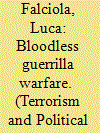

|
|
|
|
|
| Summary/Abstract |
Between 1968 and the late 1970s, a significant number of U.S. white leftist groups escalated their protest to armed struggle. After experimenting briefly with violence, they opted for low-intensity armed propaganda that targeted property and avoided hurting people. By contrast, European leftist groups and anti-colonial organizations in the U.S. made extensive use of antipersonnel violence. Why did U.S. leftists eschew attacks against civilians? Scholarship does not explain this case, as it focuses either on the internal dynamics of a single group or on structural variables. Conversely, this article addresses this question through a historical reconstruction and a multilevel analysis. The research identifies the critique and ensuing de-solidarization by the radical milieu as the main factor accounting for the restraint of violence. This article demonstrates that the radical milieu censored and isolated armed groups as soon as they escalated and began to endanger human lives. Therefore, in order to safeguard the solidarity pact with their constituencies, violent fringes moderated their repertoires of action. This article employs primary sources and original interviews with militants to support this claim and to assess the relevance of three concurrent factors: the trauma generated by the “townhouse incident,” the deterrence by law enforcement, and the militants’ socio-economic background.
|
|
|
|
|
|
|
|
|
|
|
|
|
|
|
|
| 2 |
ID:
148938
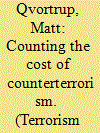

|
|
|
| 3 |
ID:
148934
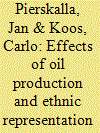

|
|
|
|
|
| Summary/Abstract |
A large qualitative literature on violent conflict in Nigeria has identified the importance of oil production and ethnicity as salient factors in understanding violence, especially in the oil-rich Niger Delta. This resonates with the broader literature on natural resources, ethnic exclusion, and conflict. This article advances existing research by providing the first highly disaggregated statistical analysis of oil, ethnicity, and violence for Nigerian Local Government Areas (LGAs). We test whether oil production in a weak state environment, and local groups’ access to governmental power, affect the level of violence in Nigeria. We employ unique disaggregated data on violent conflict events, proprietary data on oil production, and newly collected information on local ethnic groups’ access to the federal government for 774 LGAs. We find strong evidence that LGAs with oil infrastructure experience significantly more violence than others, while access to the federal government significantly reduces violence. We complement these findings with a qualitative investigation of violent conflicts in Nigeria.
|
|
|
|
|
|
|
|
|
|
|
|
|
|
|
|
| 4 |
ID:
148931
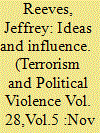

|
|
|
|
|
| Summary/Abstract |
This article demonstrates how scholarship on terrorism in China has provided the intellectual backdrop against which China's leadership has developed the country's counterterrorism institutions, policies, and laws. Building on the linkages between scholarship and policy-making, the article suggests potential avenues for policy reform in China's current counterterrorism architecture.
|
|
|
|
|
|
|
|
|
|
|
|
|
|
|
|
| 5 |
ID:
148933
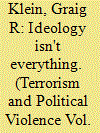

|
|
|
|
|
| Summary/Abstract |
In the current literature, the primary determinants of terrorist attack casualty rates have been attributed to religious fundamentalism. While zealotry, martyrdom, and the pursuit of salvation certainly empower religious fundamentalists with the liberty to decimate human targets, I argue that the sustaining necessity to recruit more terrorists from within the population, not religious fundamentalism alone, is an important predictor of the brutality of an attack. When targets are located within a potential recruitment population, there is an imminent need to restrict violence, as unnecessary collateral damage turns potential supporters away, rather than attracts them. Conversely, transnational attacks occurring outside the recruitment population abrogate these restrictions on violence. I test this argument on terrorist attacks from 1998–2005 and find empirical evidence that transnational attacks are a predictive cause of high casualty rates in a target population.
|
|
|
|
|
|
|
|
|
|
|
|
|
|
|
|
| 6 |
ID:
148937


|
|
|
|
|
| Summary/Abstract |
Network analysis has attracted significant attention when researching the phenomenon of transnational terrorism, particularly Al Qaeda. While many scholars have made valuable contributions to mapping Al Qaeda, several problems remain due to a lack of data and the omission of data provided by international organizations such as the UN. Thus, this article applies a social network analysis and subsequent mappings of the data gleaned from the Security Council's consolidated sanctions list, and asks what they can demonstrate about the structure and organizational characteristics of Al Qaeda. The study maps the Al Qaeda network on a large scale using a newly compiled data set. The analysis reveals that the Al Qaeda network consists of several hundred individual and group nodes connecting almost all over the globe. Several major nodes are crucial for the network structure, while simultaneously many other nodes only weakly and foremost regionally connect to the network. The article concludes that the findings tie in well to the latest research pointing to local and simultaneously global elements of Al Qaeda, and that the new data is a valuable source for further analyses, potentially in combination with other data.
|
|
|
|
|
|
|
|
|
|
|
|
|
|
|
|
| 7 |
ID:
148932
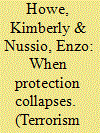

|
|
|
|
|
| Summary/Abstract |
The implementation of peacebuilding activities, including the demobilization of non-state illegal actors, does not necessarily bring about a reduction in violence. While there are several theories that address the causes of persistent violence, there are few that adequately explain why rates of violence can rapidly increase in a post-demobilization context. Using the method of process tracing, this article explores the case of Córdoba Department, Colombia, where rates of violence have increased after the demobilization of paramilitary groups (Autodefensas Unidas de Colombia [AUC]) in 2005. We argue that the AUC created and maintained a monopolistic illegal protection system during its years of operation, and this type of local order was able to contain violence. After demobilization, the protection system was disrupted and as a consequence, new competition between post-demobilization criminal organizations for existing illegal rents developed, petty crime became pervasive, and revenge killings spiked, thus contributing to increased rates of violence in the post-demobilization period. Our theory about the breakdown of protection finds support in other AUC-dominated regions of Colombia.
|
|
|
|
|
|
|
|
|
|
|
|
|
|
|
|
| 8 |
ID:
148935


|
|
|
|
|
| Summary/Abstract |
The popular media and many in academia often overstate the role that religion, and its supposedly unique qualities, has played in recent acts of terror. In this article, I argue that the notion of religious violence is unhelpful and that there is a more useful concept that we can utilize to draw out the values and ideas that play a role in the move to violence in both religious and secular groups. From a series of case studies on religious and non-religious groups, I have drawn out an alternative framework for investigating and learning from the role that beliefs play in motivations and justifications for terrorism. This framework uses the concept of non-negotiable (or “sacred”) beliefs. It is as applicable to secular as it is to religious groups, and can show us much more about how such beliefs can contribute to violence.
|
|
|
|
|
|
|
|
|
|
|
|
|
|
|
|
|
|
|
|
|